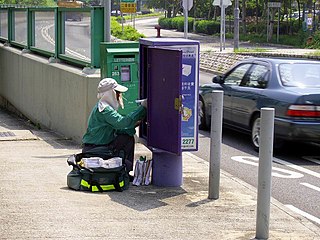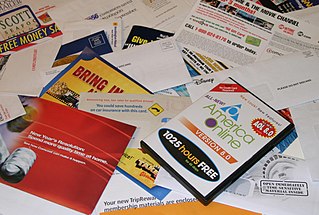Related Research Articles

A letter is a written message conveyed from one person to another through a medium. Something epistolary means that it is a form of letter writing. The term usually excludes written material intended to be read in its original form by large numbers of people, such as newspapers and placards, although even these may include material in the form of an "open letter". The typical form of a letter for many centuries, and the archetypal concept even today, is a sheet of paper that is sent to a correspondent through a postal system. A letter can be formal or informal, depending on its audience and purpose. Besides being a means of communication and a store of information, letter writing has played a role in the reproduction of writing as an art throughout history. Letters have been sent since antiquity and are mentioned in the Iliad. Historians Herodotus and Thucydides mention and use letters in their writings.
A chain letter is a message that attempts to convince the recipient to make a number of copies and pass them on to a certain number of recipients. The "chain" is an exponentially growing pyramid that cannot be sustained indefinitely.

The mail or post is a system for physically transporting postcards, letters, and parcels. A postal service can be private or public, though many governments place restrictions on private systems. Since the mid-19th century, national postal systems have generally been established as a government monopoly, with a fee on the article prepaid. Proof of payment is usually in the form of an adhesive postage stamp, but a postage meter is also used for bulk mailing.
Permission marketing is a type of advertising in which the people who are supposed to see the ads can choose whether or not to get them. This marketing type is becoming increasingly popular in digital marketing. Seth Godin first introduced the concept in his book “Permission Marketing: Turning Strangers Into Friends, And Friends Into Customers.”

The Controlling the Assault of Non-Solicited Pornography And Marketing (CAN-SPAM) Act of 2003 is a law passed in 2003 establishing the United States' first national standards for the sending of commercial e-mail. The law requires the Federal Trade Commission (FTC) to enforce its provisions. Introduced by Republican Conrad Burns, the act passed both the House and Senate during the 108th United States Congress and was signed into law by President George W. Bush in December 2003 and was enacted on January 1, 2004.

Email spam, also referred to as junk email, spam mail, or simply spam, is unsolicited messages sent in bulk by email (spamming). The name comes from a Monty Python sketch in which the name of the canned pork product Spam is ubiquitous, unavoidable, and repetitive. Email spam has steadily grown since the early 1990s, and by 2014 was estimated to account for around 90% of total email traffic.

Direct marketing is a form of communicating an offer, where organizations communicate directly to a pre-selected customer and supply a method for a direct response. Among practitioners, it is also known as direct response marketing. In contrast to direct marketing, advertising is more of a mass-message nature.

Advertising mail, also known as direct mail, junk mail, mailshot or admail, letterbox drop or letterboxing (Australia), is the delivery of advertising material to recipients of postal mail. The delivery of advertising mail forms a large and growing service for many postal services, and direct-mail marketing forms a significant portion of the direct marketing industry. Some organizations attempt to help people opt out of receiving advertising mail, in many cases motivated by a concern over its negative environmental impact.
Marketing communications refers to the use of different marketing channels and tools in combination. Marketing communication channels focus on how businesses communicate a message to its desired market, or the market in general. It is also in charge of the internal communications of the organization. Marketing communication tools include advertising, personal selling, direct marketing, sponsorship, communication, public relations, social media, customer journey and promotion.
Email fraud is intentional deception for either personal gain or to damage another individual using email as the vehicle. Almost as soon as email became widely used, it began to be used as a means to defraud people, just as telephony and paper mail were used by previous generations.
Email marketing is the act of sending a commercial message, typically to a group of people, using email. In its broadest sense, every email sent to a potential or current customer could be considered email marketing. It involves using email to send advertisements, request business, or solicit sales or donations. Email marketing strategies commonly seek to achieve one or more of three primary objectives: build loyalty, trust, or brand awareness. The term usually refers to sending email messages with the purpose of enhancing a merchant's relationship with current or previous customers, encouraging customer loyalty and repeat business, acquiring new customers or convincing current customers to purchase something immediately, and sharing third-party ads.
Email harvesting or scraping is the process of obtaining lists of email addresses using various methods. Typically these are then used for bulk email or spam.
Variable data printing (VDP) is a form of digital printing, including on-demand printing, in which elements such as text, graphics and images may be changed from one printed piece to the next, without stopping or slowing down the printing process and using information from a database or external file. For example, a set of personalized letters, each with the same basic layout, can be printed with a different name and address on each letter. Variable data printing is mainly used for direct marketing, customer relationship management, advertising, invoicing and applying addressing on selfmailers, brochures or postcard campaigns.
In marketing, the promotional mix describes a blend of promotional variables chosen by marketers to help a firm reach its goals. It has been identified as a subset of the marketing mix. It is believed that there is an optimal way of allocating budgets for the different elements within the promotional mix to achieve best marketing results, and the challenge for marketers is to find the right mix of them. Activities identified as elements of the promotional mix vary, but typically include the following:

Digital marketing is the component of marketing that uses the Internet and online-based digital technologies such as desktop computers, mobile phones, and other digital media and platforms to promote products and services. It has significantly transformed the way brands and businesses utilize technology for marketing since the 1990s and 2000s. As digital platforms became increasingly incorporated into marketing plans and everyday life, and as people increasingly used digital devices instead of visiting physical shops, digital marketing campaigns have become prevalent, employing combinations of search engine optimization (SEO), search engine marketing (SEM), content marketing, influencer marketing, content automation, campaign marketing, data-driven marketing, e-commerce marketing, social media marketing, social media optimization, e-mail direct marketing, display advertising, e-books, and optical disks and games have become commonplace. Digital marketing extends to non-Internet channels that provide digital media, such as television, mobile phones, callbacks, and on-hold mobile ringtones. The extension to non-Internet channels differentiates digital marketing from online marketing.

Content marketing is a form of marketing focused on creating, publishing, and distributing content for a targeted audience online. It is often used in order to achieve the following business goals: attract attention and generate leads, expand their customer base, generate or increase online sales, increase brand awareness or credibility, and engage an online community of users. Content marketing attracts new customers by creating and sharing valuable free content as well as by helping companies create sustainable brand loyalty, providing valuable information to consumers, and creating a willingness to purchase products from the company in the future.
A sales letter is a piece of direct mail which is designed to persuade the reader to purchase a particular product or service in the absence of a salesman or saleswoman. It has been defined as "A form of direct mail in which an advertiser sends a letter to a potential customer." It is distinct from other direct mail techniques, such as the distribution of leaflets and catalogues, as the sales letter typically sells a single product or product line, and further tends to be mainly textual as opposed to graphics-based, although video sales letters have become increasingly popular. It is typically used for products or services which, due to their price, are a considered purchase at medium or high value. A sales letter is often, but not exclusively, the last stage of the sales process before the customer places an order, and is designed to ensure that the prospect is committed to becoming a customer.
Call to action (CTA) is a marketing term for any text designed to prompt an immediate response or encourage an immediate sale. A CTA most often refers to the use of words or phrases that can be incorporated into sales scripts, advertising messages, or web pages, which compel an audience to act in a specific way.
Email remarketing refers to the email systems used by merchants to follow up with website visitors who do not make a desired purchase action. It is a development of email marketing that aims to re-attract website viewers or customers. In other words, the whole idea of email remarketing is attracting customers or users back for purchase, growing repeated customers.
The Jessica Mydek hoax was a popular chain letter, circulated by hoaxsters, to play on the sympathy of credulous readers, and get them to respond, so as to build a sucker list. The letter was first observed in 1997.
References
- ↑ Bruce Mayhew Consulting Communication Training Archived 2013-02-27 at the Wayback Machine
- ↑ The Product Marketing Handbook For Software
- ↑ "Get on the Executive Radar Screen, Part 2". Archived from the original on 2006-10-15.
- ↑ "The Ultimate Guide to Preview Text". 28 July 2021.
- ↑ "The Man who Invented the Johnson Box". Chief Marketer. 2001-05-01. Retrieved 2024-01-27.